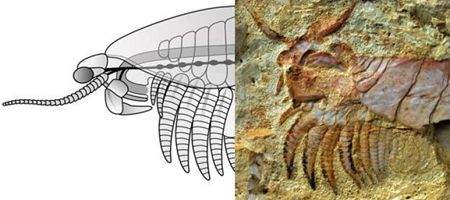A lucky find has allowed scientists to identify one of the earliest evolutionary examples of limbs used for feeding, along with the oldest nervous system to stretch beyond the head in fossil record.

Fuxianhuiid athropods existed around 520 million years ago, roughly 50 million years before primordial land animals crawled from the sea. Arthropods were the first jointed animals, enabling them to crawl.
Until now, all fuxianhuiid fossils found featured heads covered by a wide shell, making them hard to study. However, a new fossil-rich site in South China has been found to contain examples where the carapace has been flipped over before fossilisation.
And these confirm the existence of limbs under the head, used to shovel sediment into the mouth as the fuxianhuiid crawled across the seabed – possibly the earliest and simplest example of manipulative limbs used for feeding purposes.
Using a feeding technique scientists call ‘detritus sweep-feeding’, fuxianhuiids developed the limbs to push seafloor sediment into the mouth where they filtered it for food.
The fossils also revealed the oldest nervous system on record that is ‘post-cephalic’ – beyond the head – consisting of only a single string.
“These fossils are our best window to see the most primitive state of animals as we know them – including us,” says Javier Ortega-Hernández of the University of Cambridge.
“Before that, there is no clear indication in the fossil record of whether something was an animal or a plant – but we are still filling in the details, of which this is an important one.”
The team says the new site in South China where these fossils were found could be key in uncovering more information about the Cambrian explosion, when life on Earth went suddenly from multi-cellular organisms we know very little about to the first recognizable ancestors of life today.






